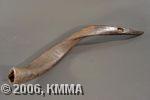



The igihuha is made from the horn of various types of antelope. The most common is that of the inzobe (sitatunga – Limnotragus spekii) because of its acoustic qualities. Other horns used include that of the indonyi (defassa waterbuck – Kobus defassa), the impongo (bushbuck – Tragelaphus scriptus), the impara (impala – Aepyceros melampus) and the inkoronko (roan antelope – Hippotragus equines). In most of the instruments made, the tip of the twisted horn is sawn off to make an air duct within the instrument. This is done intentionally in order to obtain a finger hole, which, when covered, allows another note to be played in addition to the fundamental note. The other end, the umurero bell, remains intact. Using a hot poker a 1 x 3 cm hole is made 10 cm from the tip to serve as a mouthpiece (ishako, akobo or uruvugirizo). The instrument is played in the horizontal (transverse) position, while the bell is either held in the hand or rests on the upper arm. Changing the embouchure enables other notes to be played besides the two fundamental notes. Some players also use a glissando technique.
The igihuha has a dual function:
The playing style of the igihuha therefore differs according to its function: in a hunting context short phrases are played, while for communication purposes longer, structured ‘sentences’ are more appropriate.
For more information consult the following publications edited by the RMCA:
© KMMA/Jos GANSEMANS